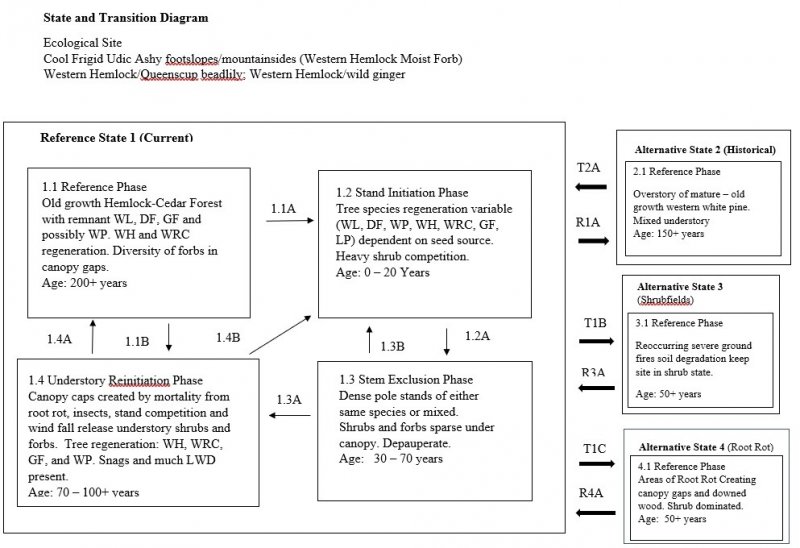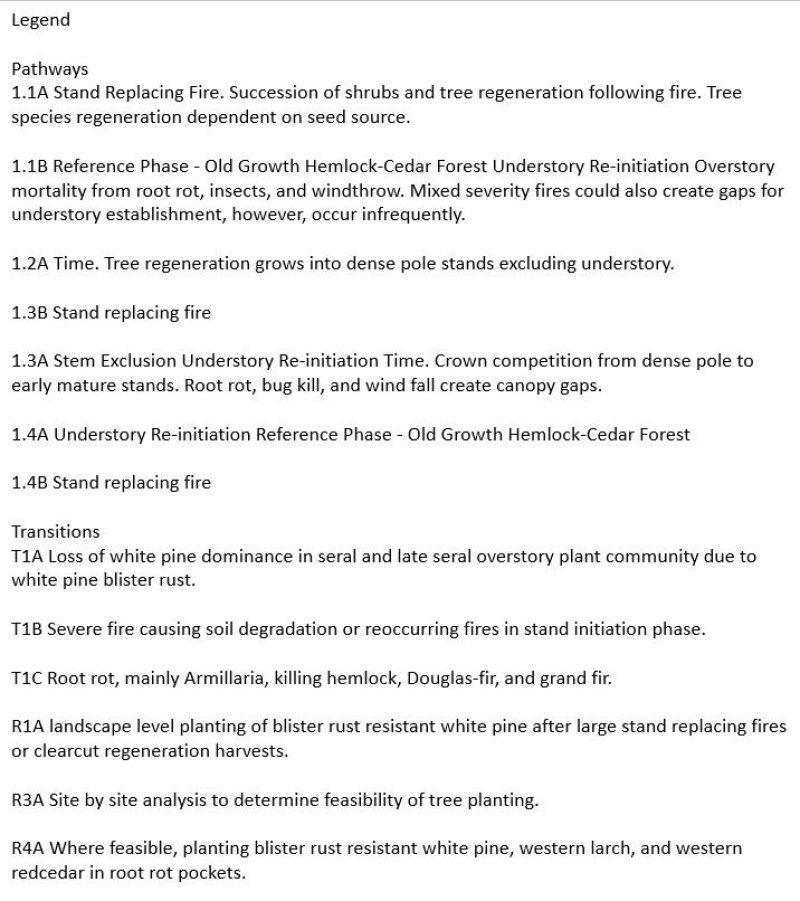
Natural Resources
Conservation Service
Ecological site F044AY505WA
Frigid, Udic, Sandy Hill slopes and Outwash terraces (Western Hemlock/Moist Forbes) Tsuga heterophylla / Clintonia uniflora , Tsuga heterophylla / Asarum caudatum
Last updated: 9/07/2023
Accessed: 11/23/2024
General information
Provisional. A provisional ecological site description has undergone quality control and quality assurance review. It contains a working state and transition model and enough information to identify the ecological site.
MLRA notes
Major Land Resource Area (MLRA): 044A–Northern Rocky Mountain Valleys
Major land resource area (MLRA): 044A-Northern Rocky Mountain Valleys
Description of MLRAs can be found in: United States Department of Agriculture, Natural Resources Conservation Service. 2006. Land Resource Regions and Major Land Resource Areas of the United States, the Caribbean, and the Pacific Basin. U.S. Department of Agriculture Handbook 296.
Available electronically at: http://www.nrcs.usda.gov/wps/portal/nrcs/detail/soils/ref/?cid=nrcs142p2_053624#handbook
LRU notes
Found in LRU 44A02 (Pend Oreille-Kootenai Valleys). This ecological site is of very small extent. Climate parameters were obtained from PRISM and other models for the area. Landscape descriptors are derived from USGS DEM products and their derivatives.
Classification relationships
Relationship to Other Established Classifications:
United States National Vegetation Classification (2008), A3612 Western Hemlock – Western Redcedar Cool-Mesic Central Rocky Mountain Forest & Woodland Alliance.
Washington Natural Heritage Program. Ecosystems of Washington State, A Guide to Identification, Rocchio and Crawford, 2015 - Northern Rocky Mt. Mesic Montane Mixed Conifer Forest (Cedar-Hemlock)
Description of Ecoregions of the United States, USFS PN # 1391, 1995 - M333 Northern Rocky Mt. Forest-Steppe-Coniferous Forest-Alpine Meadow Province
Level III and IV Ecoregions of WA, US EPA, June 2010 – 15y Selkirk Mountains, 15w Western Selkirk Maritime Forest.
This ecological site includes the following USDA Forest Service Plant Associations Western Hemlock Series: TSHE/CLUN, TSHE/ASCA. (Williams et. al. 1995)
Ecological site concept
This ecological site among the most productive in terms of forest production and biodiversity. Soils are sandy with some volcanic ash mixed in the surface. Water tables are greater than 30 inches deep, permeability is rapid or very rapid and available water holding capacity is low.
Associated sites
| F043AY577ID |
Warm-Frigid, Very Moist-Udic Loamy Foothills/Mountainsides (Western redcedar, fern) Western Redcedar / Oakfern-Maidenhair fern Sites are on foot slopes and drainageways of mountains, narrow valley floors, and low terraces. Sites are moderately cool and very moist. Textures are loamy with a distinct layer of volcanic ash present at the surface. Overstory species include Thuja plicata and Abies grandis. The understory is typified by shrubs such as Acer glabrum, Rubus parviflorus and by the presence of fern species like Gymnocarpium dryopteris, and Adiantum pedatum. |
|---|---|
| F043AY584ID |
Warm-Frigid, Aquic-Udic, Flood Plains (POBAT/POTR/COSE) Sites are found on large river floodplains. Sites are relatively warm and have high available moisture through subirrigation. They are prone to flooding unless protected. Textures are loamy and materials are mixed by alluvial activity. Sites are often a complex mosaic of trees; like Populus balsamifera ssp. Trichocarpa, and Populus tremuloides; shrubs like Cornus sericea, and Salix spp.; and herbs like Carex spp, and Deschampsia cespitosa. |
| F044AY504WA |
Frigid, Udic, Loamy Foothills and Drainageways, high water table (Western Hemlock/Moist Forbes) Tsuga heterophylla / Clintonia uniflora , Tsuga heterophylla / Asarum caudatum Found on hill slopes, terraces and floodplains. Sites have loamy textures and a water table at 30-50cm during spring. Overstory species include Tsuga heterophylla, and Thuja plicata. The understory is typified by Coptis occidentalis, Linnaea borealis ssp. Longiflora, Clintonia uniflora, and Goodyera oblongifolia. |
Similar sites
| F043AY530WA |
Warm-Frigid, Dry-Udic, Sandy Outwash Terraces, mixed ash surface (Grand Fir Moist Herb) Abies grandis/Clintonia uniflora Found warmer, drier sites on sandy outwash terraces. Overstory species are dominantly Abies grandis and Pseudotsuga menziesii var. glauca. The understory is typified by Acer glabrum, Linnaea borealis ssp. Longiflora Clintonia uniflora, and Coptis occidentalis. |
|---|---|
| F044AY504WA |
Frigid, Udic, Loamy Foothills and Drainageways, high water table (Western Hemlock/Moist Forbes) Tsuga heterophylla / Clintonia uniflora , Tsuga heterophylla / Asarum caudatum Found on hill slopes, terraces and floodplains. Sites have loamy textures and a water table at 30-50cm during spring. Overstory species include Tsuga heterophylla, and Thuja plicata. The understory is typified by subshrubs and forbs including Coptis occidentalis, Linnaea borealis ssp. Longiflora, Clintonia uniflora and Goodyera oblongifolia. |
Table 1. Dominant plant species
| Tree |
(1) Tsuga heterophylla |
|---|---|
| Shrub |
(1) Coptis occidentalis |
| Herbaceous |
(1) Clintonia uniflora |
Click on box and path labels to scroll to the respective text.

